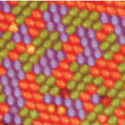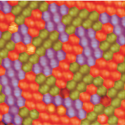Caged atoms in fullerenes made to order
Endohedral metallofullerenes—fullerenes enclosing metallic atoms within their interior—show interesting optical, electronic, and magnetic properties due to charge transfer from the metal to the carbon cage. They are also quite stable compared to pure fullerenes, which are highly reactive. The prototypical system, a trimetallic nitride enclosed in , is known to exhibit ordering of the endohedral unit. This raises the possibility of manipulating small clusters of endohedral fullerenes into ordered arrays where information can be stored by switching the orientation of endohedral units.
Presenting their work as a Rapid Communication in Physical Review B, Matthias Treier and collaborators from Switzerland, Germany, and China have carried out a detailed study of (sub-) monolayers of endohedral trimetallic nitride fullerene in on using scanning tunneling microscopy (STM) and resonant x-ray photoelectron diffraction. Treier et al. find that these objects form an ordered superstructure on the template, with both the carbon cage and the endohedral unit ordered with respect to the substrate. High-resolution STM images find three rotationally equivalent molecular orientations of the cage with equally oriented molecules forming small domains of 5–15 molecules within larger islands. The data show that, while nitrogen remains near the center of the cage, the unit takes at least two inequivalent orientations in the cages on the substrate. These findings open the way for exploring the manipulation of the endohedral orientation via external fields for nanoscale information storage. – Sarma Kancharla





